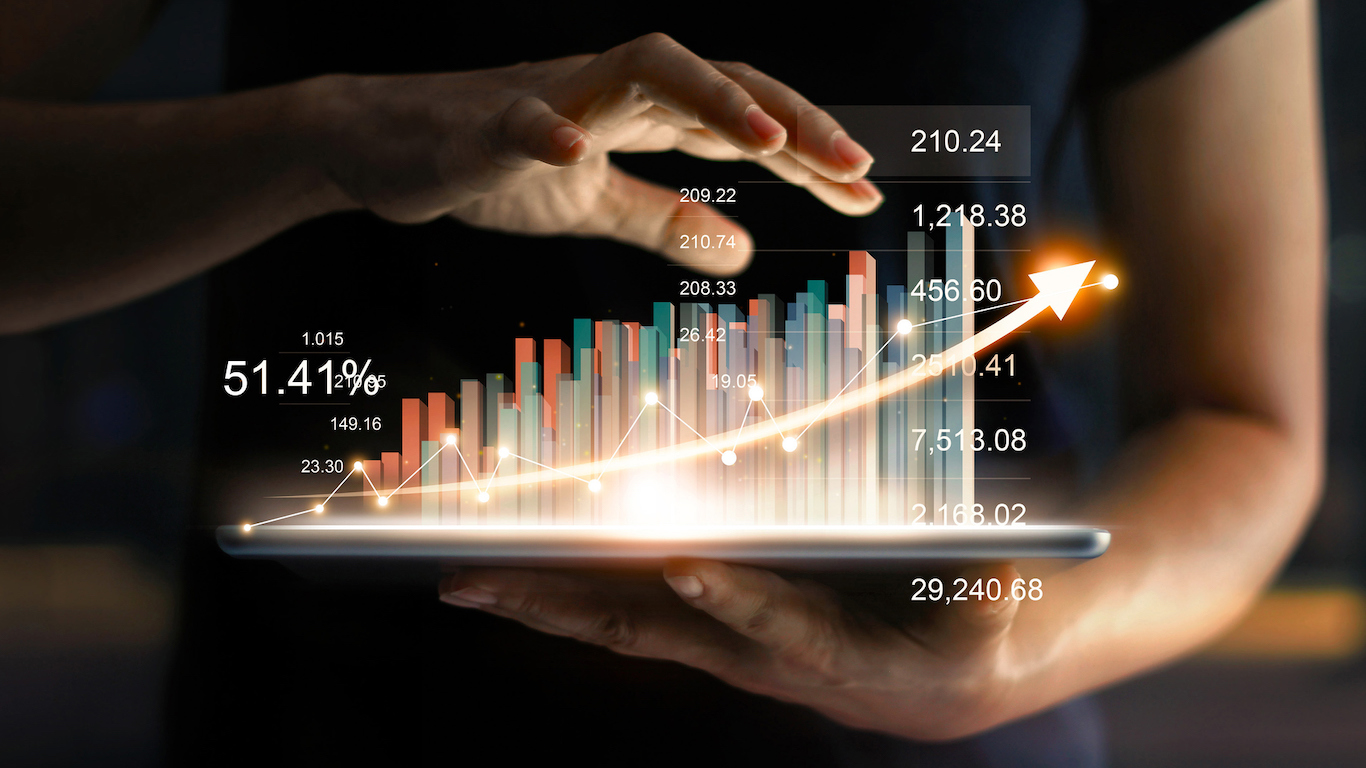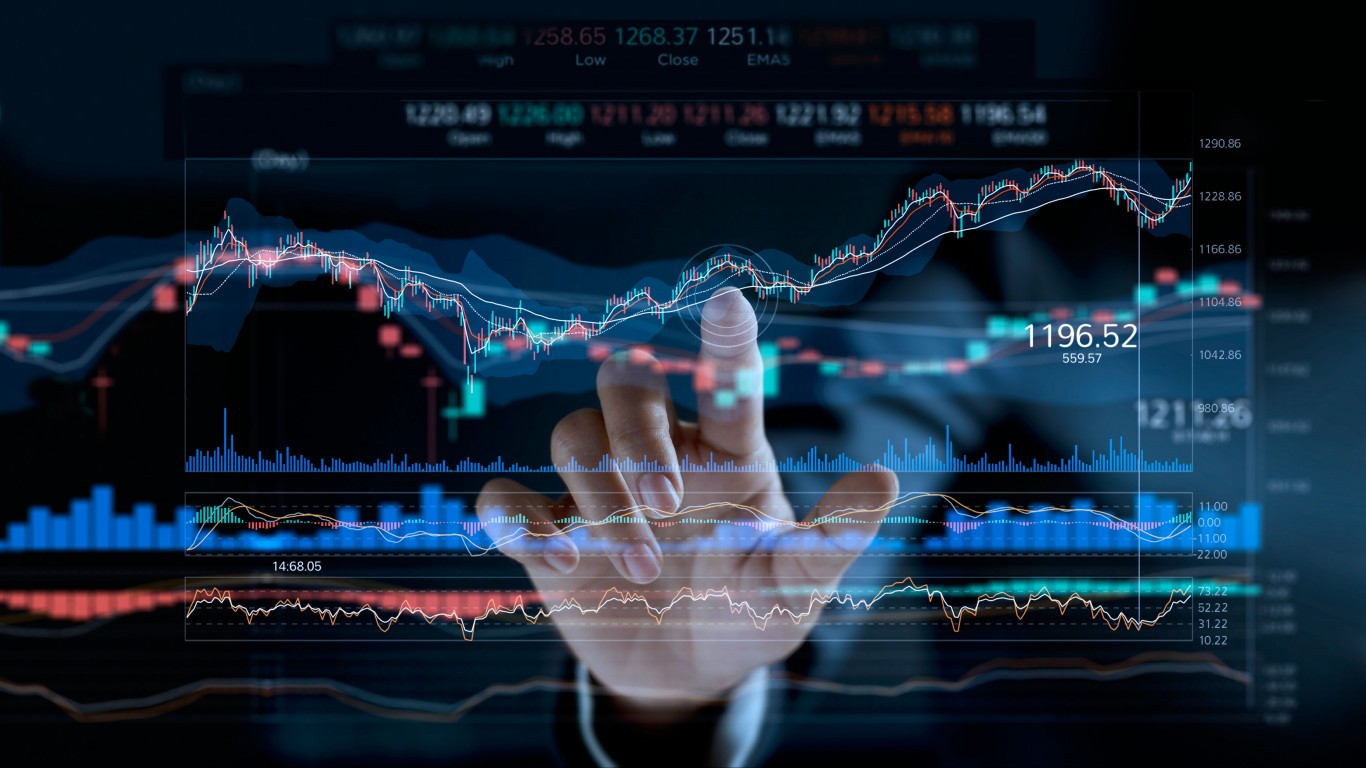
Now that the strong gains have been seen in 2019, it’s time to look backward and forward to get an idea of what to expect for 2020. The stock market gains of 22.3% in the Dow Jones industrial average and 28.9% in the S&P 500 in 2019 were nothing short of spectacular. Many investors will worry that the strength at the end of 2019 will have eaten into potential upside that could have been seen in 2020. One issue that may put those fears to rest is that the S&P 500 index closed out 2019 only about 10.2% from that prior 2018 peak before the late-2018 panic selling took over. Now the stock market gains suddenly do not seem too crazy, and what seemed like an unbelievable Dow forecast of 28,000 in 2019 was reached and then some.
24/7 Wall St. has issued a Bull/Bear review for the stock market for the past decade. Our methodologies average out the Dow’s consensus price targets on each of the 30 components and add in dividends for an expected total return. While 2019 was grand, some things could have juiced up the returns even better than were seen last year. Since those did not come to pass, it’s quite possible that the disappointments and other leadership efforts could add to the expected baseline for 2020.
Our official 2020 baseline model was for the Dow to generate a total return of 7.4% and rise to roughly 30,650 over the course of the year. With interest rates expected to remain low, with a China trade pact waiting to be signed and with earnings growth and global growth potentially come back, there are a few issues that could easily make an expected 7.4% gain in the Dow look more like a gain of 10%, 12% or even higher.
Recall that the Dow is a price-weighted index. The index calculation is quite antiquated as it completely ignores market capitalization in the weighting. This means that the top six Dow stocks account for about 37.5% of the entire index, while the bottom third (10 stocks) account for not quite 15% of the entire weighting.
Including an upside scenario is not meant to override any downside scenarios. These positives could easily happen, but there are many negatives that could wipe away the smiles from the bulls on Wall Street. Iran and Middle East tensions could brew back into an escalation of troop deployments and ongoing conflict. A more vocal North Korea could become more antagonistic. The trade deal with China could prove to be a dud or backfire. Earnings growth and gross domestic product could disappoint. Global growth being rekindled also could falter. The populism of taxing wealth and assets is still not dead in the water, and the endless costs of free medical care for all and spending for the environment over growth and the economy could pose troubles. All that considered, there are still risks that have to be weighed.
24/7 Wall St. has reviewed the top six Dow components by weighting, as well as some additional components, that could take the Dow up by 10% to 12% rather than the baseline of just 7.4%. If that comes to pass, then the Dow’s rise to 30,650 could easily be up to a range of 31,350 to 32,000 before investors have to start seriously worrying that the market is back to being too far ahead of itself. Here is a rather simple path of how that would occur, and we have used index weightings from indexArb.com for the Dow and consensus analyst target prices are from Refinitiv.
Boeing Co. (NYSE: BA) has close to an 8% weighting in the Dow. While it barely posted a gain at all in 2019, it lost 27% of its value from the peak. After closing ending the year at $325.76, the year-end target price of $366.40 implied a total return expected of 15%. That likely will depend solely on Boeing’s 737 Max fleet status as 2020 matures. The CEO was axed, and the basic assumption is that the jet will be recertified sometime in 2020, after Boeing had to shutter production at the start of the year. If that occurs and no additional hiccups wreck its shares, Boeing’s stock target prices could easily climb back over $400 for close to a 25% total return.
Apple Inc. (NASDAQ: AAPL) was the Dow’s best performing stock in 2019. Its weighting is better than 7% at the start of 2020, and the year-end price of $293.65 already has seen its subpar consensus target price lifted during the first week of 2020. Most analysts at this time do not want to have “Sell” ratings on Apple, so the pool of analysts is likely to keep lifting the price targets. The most bullish analyst was from Wedbush Securities, with a $350 target price, but he has even offered up an outline that would get Apple up to $400 under the right circumstances: China trade, the iPhone supercycle from 5G in 2020, successful gains seen from Apple TV, apps and services. Even if the $350 level seems high, a 10% return would only require Apple to rise to about $320, a level that already has been passed by some more recent analyst calls.
UnitedHealth Group Inc. (NYSE: UNH) had a 6.8% Dow weighting at the end of 2019, and its $293.98 share price compared with a consensus target price of $310.32 and implied a gain of over 7%, after returns of 18% last year. If the health insurance industry loses the threat of Medicare for All and universal care for another four years, all of which is financially and mathematically challenged by reality, then suddenly investors will want to own even more of the nation’s largest corporate health insurer. At that point, a gain of 10% might seem too paltry and some investors might be thinking a gain of 15% or even 20% would not be outside of the realm of possibilities.
Goldman Sachs Group Inc. (NYSE: GS) had a 5.5% weighting in the Dow, but the year-end price of $229.93 brought on a return of better than 37% last year. The premiere investment banking giant has been moving more toward retail and consumers (rather than just the wealthy and institutions), and if that pays off it could bring huge rewards. The consensus target price of $244.73 implied an expected total return of 8.6%, after adding in its 2.2% dividend yield, in 2020. Excitement grew around some segment reporting changes that were announced, and the new CEO is expected to be a more friendly communicator with regulators, according to some. Goldman Sachs was marred by controversy in late 2018 and in early 2019, and it’s very possible that, as those negatives fade into history, analysts will become more warm. Wells Fargo even issued a $280 target price in recent weeks, which would imply gains of more than 20% this year.
Home Depot Inc. (NYSE: HD) had a 5.2% weighting in the Dow, and its return of 27% in 2019 would have been better had it not run into some unexpected hiccups. All Home Depot has to do is manage to hold its lead over rival Lowe’s and to have a stronger housing market and a super-low unemployment rate help it grow revenues better than just the 2% in 2019 and 4% for 2020. The consensus target price of $233.28 was not even quite above the 52-week high and implied an expected gain of 9.3% after the 21.5% yield is included. If the company gets its earnings back on track, then Home Depot could be looking at potential gains of 15%, or even 20%, before analysts start screaming about valuations getting too stretched.
McDonald’s Corp. (NYSE: MCD) ended with a 4.8% weighting in the Dow, and its year-end price of $197.61 was still up more than 11% in 2019. That said, McDonald’s would have to rise more than 12% just to get back above its prior high of $221.93. The consensus target is $223.07, implying an expected gain of more than 15%. If McDonald’s can continue improving under its brand new CEO and can continue in its recent past of returning great sums of capital to shareholders, it’s quite possible that its gains could outpace expectations.
3M Co. (NYSE: MMM) continued to languish in 2019, and its weighting is 4.2% of the Dow. Its fourth-quarter gain of over 11% helped curb the losses to only 7.4% for the year. Trade tensions easing should help 3M’s China sales, and any communication by management that it will be able to get to the bottom of its ongoing margin erosion issues will instill confidence. It’s also possible that an activist investor could bully the company while it continues to restructure and trim fat. This stock was down close to 30% from its highs at one point, and analysts may have been too negative with a $171.44 consensus target price after it closed out 2019 at $176.42. 3M has raised its dividend for decades, and any improvement and earnings visibility would give investors comfort that its shares could rally another 10% to 20% before the street demands more “show-me” results.
Microsoft Corp. (NASDAQ: MSFT) was the Dow’s second-best gain in 2019, with over 55% returns. What is amazing is that Satya Nadella has taken Azure into a direct front with Amazon’s AWS in the cloud, and despite the Department of Defense’s cloud contract being disputed, the $10 billion JEDI award is still more likely than not to end up staying with Microsoft. Microsoft also has a new refresh of the Xbox video game console coming out at the end of 2020, and the company continues to win from its online Office and software sales on desktop PCs. The consensus target price of $163.63 implied a return of just 5.1% after dividends from the $157.70 year-end price. Any continued upside in earnings and any favorable JEDI pact ruling would add greatly to Microsoft’s expected returns, and analysts might be confronted with having to issue price targets up closer to $200 if the bull market keeps raging.
International Business Machines Corp. (NYSE: IBM) has only close to a 3.2% weighting in the Dow, but this stock is so battered and is valued so low (10 times earnings) that any upside surprises, and even less of a bleed in the old IT-services contracts, could take an expected gain of 15% from its $134.04 year-end price much higher. Imagine if IBM were to announce it was looking for a new CEO, or imagine if Red Hat begins to pay off above its baseline potential. Imagine if IBM’s strategic imperatives regain interest. IBM used to be over $200 a share, and its stock has not moved anywhere but down for most of the past decade. Just a hint of increasing revenue growth might rekindle Wall Street interest with much stronger expectations.
Using this baseline model has worked well for trying to look at a peak value rather than for a year-end price target. That said, all investment models have imperfections and may not reflect some drastic unknown changes that await, and there always seems to be some unexpected winners and some unexpected losers over the course of any given year.
It would not require much more than two or three of these upside scenarios to handily create even higher upside in 2020. There is no preset rule of where stocks will go over the course of any given year.
Are You Ahead, or Behind on Retirement? (sponsor)
If you’re one of the over 4 Million Americans set to retire this year, you may want to pay attention.
Finding a financial advisor who puts your interest first can be the difference between a rich retirement and barely getting by, and today it’s easier than ever. SmartAsset’s free tool matches you with up to three fiduciary financial advisors that serve your area in minutes. Each advisor has been carefully vetted, and must act in your best interests. Start your search now.
Don’t waste another minute; get started right here and help your retirement dreams become a retirement reality.
Thank you for reading! Have some feedback for us?
Contact the 24/7 Wall St. editorial team.

 24/7 Wall St.
24/7 Wall St.



